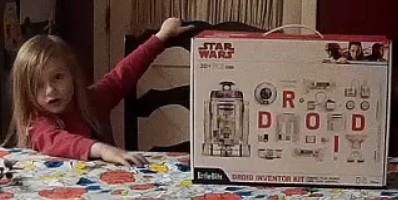Little Bits Droid Inventor Kit - LMR Review
Who hasn't at some time in his or her life thought, "I wish I had an R2D2..."? R2 is surely the most famous robot ever, and its platform isn't all that unrealistic. Two wheels, a speaker from which it talks in droidspeak, sensors, an arm, and a rotating head. All perfectly plausible, but building one from scratch is far from a beginner project. Nevertheless, the Little Bits Droid Inventor Kit provides everything a beginner would need to do just that - build an R2D2 essentially from scratch.
Building a robot from scratch, such as an R2D2, requires skills in three broad areas - mechanical engineering, electrical engineering, and computer programming. Little Bits has conquered the basics of those three areas for the robot builder, but leaves plenty for the builder to do. The builder still assembles hardware, still electronically connects the parts, and still programs logic dictating R2's actions.
Mechanically, the construction of R2's legs has already been done, complete with motor mounts. The single steering wheel is already well located and has the strength to steer and support the weight of the robot. Those are not exactly the easiest things to conquer for a beginner.
Electrically, all parts connect via Little Bits magnetized connectors. The magnetic polarity prevents the builder from accidentally connecting positive to negative. No soldering is required. Nevertheless, the builder still has to connect power to the microcontroller, microcontroller to the servo controller, servo controller to the servo, sensors to the microcontroller.
Programming R2 is done via the free Android/IOS app. Initially, the app is used to build R2. Each step of the build is set up as a mission. The missions are presented with animations, text instructions, and audio instructions. Once R2 is constructed, the missions get more complex and the builder is taught how to make R2 autonomous, and how to create basic logic that the autonomous R2 follows. Using the included proximity sensor, you can program R2 to drive until it detects an obstacle, then turn, then continue, and so on.
The Components:
The Droid Inventor Kit comes with the following components:
- the R2D2 body (cylindrical body, dome head, two rear drive arms)
- two rear wheels, a rear differential that you assemble, and a front wheel
- one DC motor, used as the drive motor via the rear differential that drives the two rear wheels
- one servo, used to steer R2D2's front wheel
- one proximity sensor - an infrared distance sensor, used to detect obstacles
- connector bits that connect the electrical components
- a microcontroller with a built-in speaker and Bluetooth
- a 9v battery that powers the microcontroller and the motors
- an arm that resembles R2D2's computer-interface arm
The first missions walk the builder through constructing a remote-control R2D2 that can be driven around using a phone or tablet. All the familiar R2D2 sounds can be emitted on command via the app. Later missions lead the builder through making R2D2 autonomous, connecting a pen to make R2D2 a drawing bot, making R2D2's drive controlled via moving your hand in front of the proximity sensor, and reconfiguring the servo motor to operate the arm or head instead of the steering wheel.
One great (perhaps the greatest) thing about the Droid Inventor Kit is that it's based upon Little Bits parts, and it can be expanded by a huge variety of additional components. You can buy additional servos, replace the microcontroller with a Little Bit Arduino (a 32U4 with three inputs and three outputs), or even create your own electronic bits with their blank breadboard bits. I've done that with their Korg Synthesizer kit, using an Arduino to create a traditional MIDI input to control it from external MIDI keyboards. As the R2D2 builder's skills advance, there's plenty of room for the R2D2 platform to keep on entertaining.
The Build:
Rather than build R2D2 myself, I chose to turn it over to some beginners - my wife, daughter, and 4yr old grandson. None of them has ever built a robot, programmed a microcontroller, or soldered. True beginners.

The build time for them to get from unboxing the parts to driving an assembled R2D2 was about an hour. There were plenty of "instant gratification" moments along the way to keep them entertained with the build. One of the earliest missions is connecting the battery to the microcontroller, and Bluetooth pairing the app. Once that's done they were able to hear R2D2 making sounds, and of course, the signature R2D2 scream.
The tutorials presented via the app and its missions are very well done. The orientation of things is always considered, and at no time did my wife/daughter/grandson have to ask me for help. They just kept chugging along, mission by mission, part by part, until R2D2 was driving around the kitchen. I've built a lot of robot/RC kits over the years, and I'd rank this one as the easiest of all, and probably the most expandable of all beginner kits.
Pros:
- zero mechanical, electrical, or programming skills required
- includes all components required to build the robot
- advances all the way to autonomous control, and is not simply another remote-control vehicle
- can be expanded by a huge variety of Little Bits components, including Arduinos, DC motors, and servos
Cons:
- the app is HUGE, and might take a while to download. Get that install started early.
- the microcontroller is limited to three I/O at time
The Conclusion:
I would recommend the Little Bits Droid Inventor Kit to any robotics beginner aged four and up with assistance, or aged eight or so without any assistance. For those that have built a few robots already from kits or built robots from scratch, I think this kit might be a bit too basic and not very challenging. For a Star Wars enthusiast that likes R2D2 robots, this would be a fine addition to whatever other R2D2 robots and kits there are on the market. Its expandability is going to be hard to beat.
Two thumbs up. 4/4 stars. With it, the force is.
Remote control via Android/IOS App, autonomous control via logic, make R2D2 sounds, avoids obstacles
- Actuators / output devices: 1 Servo, 1 speaker, 1 dc motor
- Control method: autonomous, Bluetooth
- Power source: 9v battery
- Sensors / input devices: infrared
- Target environment: indoor


